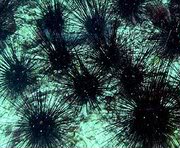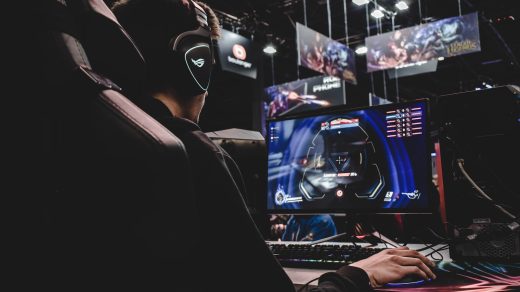 Sea urchins, locally known as “swaki, santol-santolan, maritangtang, and kuden-kuden”, are invertebrates that look like a ball of spines which feed on sea grasses and seaweeds particularly Sargassum sp. or Aragan.
Sea urchins, locally known as “swaki, santol-santolan, maritangtang, and kuden-kuden”, are invertebrates that look like a ball of spines which feed on sea grasses and seaweeds particularly Sargassum sp. or Aragan.
Sea urchins can grow up to 7-9 cm with an average weight of 1 pound. They are usually found in colder off-shore water. Sea urchins are harvested mainly for their internal roe or gonad know locally as “alige or bugi”.
Why Culture Sea Urchins and what is its importance?
* For human consumption (believed to have aphrodisiac properties).
* As a source of Income
* Has high demand both in local specialty restaurants and international market
* Has lucrative market in Japan, France, Korea, China and other Western countries
* Culture area serves as mini reproductive reserve
I. Culture Technology
Cage Culture
A. Site Selection
* The site should have a high water movement and tidal flushing with salinity range of 30-35 ppt.
* Should be sheltered from storms and bad weather
* It should also be far from nearby freshwater sources such as river mouths
* Sufficient water depth (at least 1- 1.5m deep at low tide.)
* The should also have abundant source of sea urchin food (Sargassum)
* Visible and easily accessible from the shore not situated along frequently used boat routes where bancas might run over the cages.
B. Cage Construction
The materials used are hard bamboo, steel bars or PVC pipes for frames covered with green polyethylene screen or net size 3/4 as enclosure. Cage dimension is 1.5m x 0.5m x 1.0m
C. Cage Installation
The constructed cages are installed on the sea floor by tying its four corners to bamboo or wooden stakes firmly driven to the sea floor. The cage should be elevated at least (1) foot above the seafloor and the top should be about 0.5 m below the seawater surface during low tide. The cage should be spaced a few feet apart to ensure sufficient water flow in the area. A marker (tall bamboo pole) should be erected to warn approaching boats of the presence of the cages.
D. Acquisition of Stocks
Sea urchin seed stocks can be gathered from the site if there is abundant supply of it. Juvenile sea urchin usually measures from 32-44 mm in equatorial diameter. Seed stocks can be gathered thru simple picking. If the source of seed stock is far from the grow-out area, proper transporting procedure should be strictly followed. Live sea urchins while in transport should be kept in Styrofoam iceboxes (with aerators similar to aquariums) that contain seawater. About 500-600 urchins can be place in one Styrofoam box. It is recommended to transport the seed stock early in the morning when the temperature is lower. Sea urchins, regardless of how they are transported, should not be abruptly transferred from the transport containers directly to the sea cages because sudden change in water conditions can further stress the urchins and may cause them to die. Acclimatize first the seed stocks before stocking to the cages by floating the container in the seawater in the area for a few minutes and slowly pouring the seawater into the container until the stocks can already adopt with the environment in the area.
E. Stocking
Initial stocking density of 500 pcs. per cubic meter is recommended. Thinning of the stock is done as they grow by transferring the smaller ones to another cage usually a month before harvesting. Stocking should be timed to avoid the typhoon months at harvest time.
F. Feeding
Feeding is done once or thrice a week in “ad libitum” manner preferably with fresh Sargassum or aragan. There should be enough amount of sargassum left in the cage to ensure that urchins feed at maximum rates, grow faster, and consequently develop large gonads. When gathering sargassum for feeding, cut only the branches, and do not uproot the plant to ensure sustainability.
G. Maintenance
Maintenance includes regular monitoring of the stocks, cleaning and removing of decaying left over algae and other debris being entangled on the screen. Thinning is done to make sure that all of the stocks grow optimally. It is also necessary to guard the cages against poachers and vandals.
H. Harvesting
Sea urchins will be harvested once they reached 7-9 cm. Depending on market considerations. This will be sold live or the roe may also be processed and packed before selling. Sea urchin roe can be sold fresh, packed in brine or in the form of paste.
II. Estimated Project Cost (1 unit 1.5m x .5m x 1.0 m)
| PARTICULARS | UNIT COST | TOTAL COST |
| A. Cost of Material | ||
| 10 pcs. hard bamboo (6 ft; 2" diameter) | P60.00 | P600.00 |
| 7m polyethylene screen (3/4) | P150.00 | P1,050.00 |
| 1/4 kg Monoline # 150 | P300.00 | P75.00 |
| 10m PE rope #3 | P20.00 | P200.00 |
| Sub Total | P1,925.00 | |
| B. Labor in construction of 1 unit Cage | P250.00 | P250.00 |
| C. Cost of 500 pcs. sea urchin juveniles | P3.00 | P1,500.00 |
| Total cost of 1 unit Cage | P3,675.00 |
III. Economic Analysis
A. Assumptions
No. of cropping per year – 1
Culture period – 6 months
Stocking density – 500/ cage
Survival rate – 85%
Total production (pcs) – 425 pcs.
No. of pcs./ kg – 8 pcs.
Total production (kg) – 53 kg.
Price/ kg. (fresh) – P80.00
B. Cost and Return
Sales (53 kg @ P80/kg.) – P4,240.00
Less Expenses:
Cost of Sea Urchin juveniles – P1,500.00
Depreciation cost – P300.00
Marketing cost – P212.00
Total Expenses: P2,012.00
Net Income: P2,228.00
ROI = Net Income/ Total Expenses x 100
ROI = 2228/2012 x 100
ROI = 110%
Source: BFAR (Tuguegarao City)
Photo credit: tidechaser.blogspot.com
Do you like this money making business idea? content”> then please consider subscribing to our RSS feed. You can also subscribe by email and have new articles sent directly to your inbox. (Once you entered your e-mail address, you need to login to your e-mail account and click the link to confirm your subscription).




Hi! In what places could I find the best sea urchin? Places where sea urchin is now being cultured?
hi! you seem very knowlogeable on sea urchins. im am very interested in knowing more about it. would mind giving me your email address so i can reach you about my concerns.
Thanks for every one of your work on this web page. Betty enjoys making
time for internet research and it is simple to grasp why. Most people know all
relating to the dynamic medium you make practical suggestions on the web site
and as well as encourage contribution from some others on that concept while my
child is without a doubt becoming educated a lot of things. Have fun with the
rest of the year. Your doing a pretty cool job.